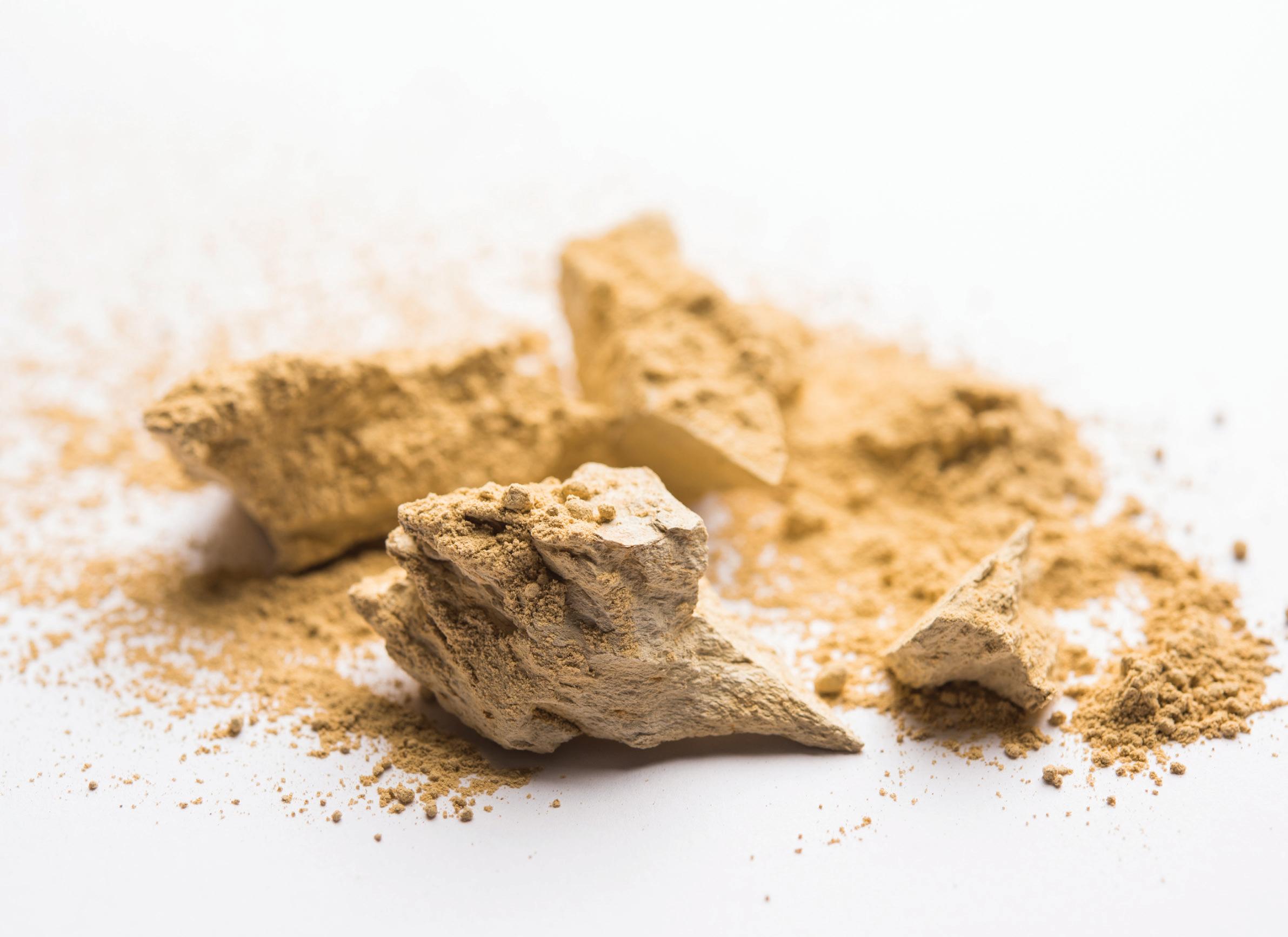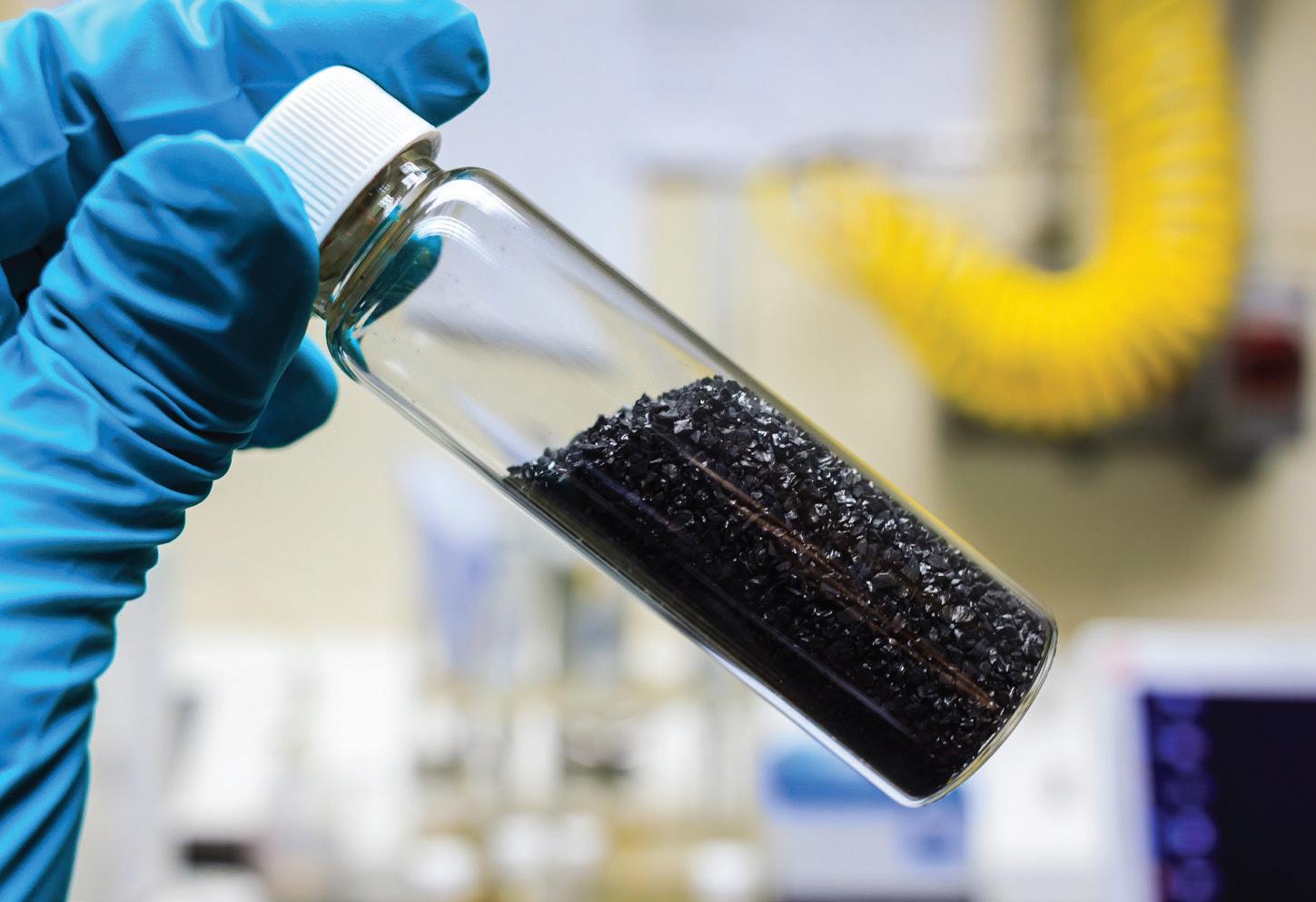
9 minute read
Treating feedstocks
Fuller’s Earth was traditionally mixed with oils and fats to achieve a purified product Photo: Adobe Stock
From past to future
Historically, the main aim in treating oils and fats was to clarify, make the oil/fat more palatable and increase the period before it became rancid. This was achieved using ‘Fuller’s Earth’ powder that was mixed with the oil/fat, then separated from the oil/fat to give the purified product.
Natural Fuller’s Earth powder from England, which is bentonite (montmorillonite)-based, was of superior performance to Fuller’s Earth from other countries.
German scientists then discovered that acid leaching of their local Fuller’s Earth improved its impurity removal performance and, at the same time, reduced the colour of the oil being treated to a greater extent compared with natural Fuller’s Earth. As a result, acid-leached Fuller’s Earth was marketed as ‘bleaching earth’. Since that time, the focus has been on bleaching earths that give the lowest coloured bleached or fully-refined oils.
Today, bleaching earths have an especially important role in the refining of oils and fats. The term ‘bleaching earths’ does not adequately describe all their functions. Bleaching earths have evolved from removing primary and secondary oxidation products and undesirable pigments to playing a key role in the remediation of dioxins, pesticides, PAHs and 3-MCPDs Dr Patrick Howes
Wider role
Bleaching earths are required to reduce or remove residual soaps, trace metals and gums remaining in an oil after the neutralising and degumming processes. Historically, the main function of bleaching earth was to remove the primary and secondary oxidation products, and toxic- and cosmetically-undesirable pigments. In recent years, the bleaching stage has also been required to play a key role in the remediation of polyaromatic hydrocarbons (PAHs), dioxins, pesticides and 3-monochloropropane diol (MCPD)s.
To achieve all these functions, some leading bleaching earth manufacturers have designed carefully formulated highperformance bleaching earths, consisting of ingredients that can meet the challenges of the additional requirements. Silicas, silicates and active carbons are the most common ingredients.
Natural, acid-leached and formulated bleaching earths work with three main actions: absorption, ion-exchange and acid-catalytic.
Absorption removes the bulk of the impurities, ion-exchange removes the polyvalent harmful trace metals, and acid-catalytic action decomposes primary oxidation products and pigments.
Of these actions, ion-exchange and absorption are the most desirable as they do not alter the beneficial nutritional properties of the oil being processed.
Acid-catalytic action, although useful, can also cause some undesirable side reactions, such as cis- to transisomerisation and double-bond shift, particularly in unsaturated oils, u

Photo: Adobe Stock
Activated carbons absorb both inorganic and organochlorines and thus play an important role in the mitigation of 3-MCPDs
u and double-bond conjugation and polymerisation in polyunsaturated oils.
Many trans-isomers are believed to be harmful. Other undesirable properties of trans-isomers are their higher melting points compared with cis-isomers. This adversely affects the cold stability of the oil, resulting in a slightly lower olein yield when fractionating palm oil.
Double-bond shift can change the biological functionality of the oil, for example, anti-inflammatory omega-3 oil can be transformed into pro-inflammatory omega-6 oil. Double-bond conjugation adversely affects the oxidative stability of the oil to a high degree relative to its natural non-conjugated form. Polymerisation of polyunsaturated fats raises the viscosity of the oil.
Acid catalytic formation of 3-MCPDs during the bleaching stage has also been found for oils containing inorganic and/or organochlorine molecules together with partial glycerides, when acidic bleaching earths are used.
For these reasons, bleaching earths with predominantly absorptive action are generally preferred over those with acidcatalytic properties. Acid-catalytic cracking is, however, useful for decomposing pigments that are too large to fit within the pores of the bleaching earth.
Activated carbons have historically been used as bleaching earths and are available with a full range of pore sizes. The main problem with the highestperformance activated carbons is their relatively high price, and their tendency to disintegrate into fines that cause clogging and breakthrough in filters. It is therefore important to select activated carbon that have good structural integrity to eliminate the problems with fines.
Activated carbons are increasingly utilised in formulated bleaching earths to aid the removal of undesirable components that are too large to be absorbed within the pores of conventional bleaching earths.
Of the high-performance materials, highly acid-activated bleaching earths and activated carbons are generally sensitive to high-shear environments such as sharp bends during pneumatic conveying and pumping when in oil slurry.
Shear can detach the silica fronds on acid-activated bleaching earths, reducing the bleaching performance and adversely affecting oil filtration properties. Similarly, shear will break down highly activated carbons and adversely affect the oilfiltration properties. To overcome these problems, it is advisable to control the degree of activation to a level where the structural integrity of the material is preserved when utilised under normal refiner conditions.
Bleaching parameters
The main parameters controlled by bleaching earth manufacturers are activity, oil filtration time (OFT), moisture content, acidity (pH) and bulk density.
Activity is a measure of bleaching/ impurity removal performance. OFT is an indicator of the oil filtration rate/filter press throughput capability. Moisture content is the percentage of water content, pH is a measure of acidity, and bulk density is a volumetric measure.
High activity is desirable as less bleaching earth will be required. However, the higher performance may come with downsides of poorer OFT and higher oil losses in the spent bleaching earth, so overall cost-effectiveness versus performance must be considered.
Increased grinding of bleaching earth will generally give lower bulk density and higher activity but the OFT and oil loss in the spent bleaching earth will increase.
The cost of the oil lost in the spent bleaching earth is a very important factor when selecting the most appropriate grade of bleaching earth.
Low OFT represents fast filtration, which is generally desirable as it represents potentially greater potential throughput at the filtration stage. However, this is good to a point, as an OFT which is too low will reduce the press-bleach effect, so that the full potential of the bleaching earth is not achieved.
Nobody likes to buy water but it is a functional component of bleaching earth that aids its performance. Ideally, from a performance standpoint, the moisture content of bleaching earth should be as high as possible, while still maintaining the bleaching earth as a free-flowing powder. For this reason, some bleaching earths have moisture contents of 15-18%. If the moisture content is below about 10%, the bleaching performance begins to fall due to insufficient hydration of the cations, leading to a reduction in pore size.
Bleaching earths are powerful absorbents and easily pick up moisture from the atmosphere. It is for this reason that some bleaching earths are dried to lower moisture content, to ensure that their flow properties are maintained after transport, storage and handling. pH is a measure of acidity. Historically, acid-activated bleaching earths have been very acidic, eg pH2 to pH3. These days, refiners are more aware of the adverse effects of low pH on the nutritional and physical properties of the oil, particularly the oxidative stability, solid fat content and viscosity. Some high-performance bleaching earths are neutral or close to pH7.
Bulk density generally has an inverse corelation with the oil retention of the spent bleaching earth. Higher bulk density allows a greater weight of bleaching earth to be filled into silos and into containers when shipped.
With ocean freight rates being extremely high at the moment, higher bulk density allows the minimisation of the transportation element of the bleaching earth costs.
Bleaching earth properties
The most popular natural bleaching earths on the market today are based on bentonite clay, attapulgite (a magnesium aluminium phyllosilicate) or sepiolite (a clay mineral).
Bentonite has a leaf-like layered structure, somewhat similar to the clay mineral talcum, where impurities can enter the porous spaces from four edges.
Attapulgites and sepiolites have tubular structures, like a bunch of straws, where the impurities can only enter the pores from the two ends of the tubes. Bentonite powder was historically utilised for powdering babies bottoms, whereas attapulgites and sepiolites have a fibrous or needle-like morphology that can cause irritation to skin and to lungs if inhaled.
Bentonites-based bleaching earths have lower oil retention in the spent earth, while attapulgite- and sepiolite-based bleaching earths have significantly higher oil retention.
Surface-modified bleaching earths are natural clays that have been surfacetreated with acid, without washing away the resultant acidic salts. Surface modification is sometimes referred to as dry processing, as there is no acid-slurry stage. This class of bleaching earths retains its natural activity and has some of the acid-catalytic properties of conventional acid-activated earths. Surface-modified bleaching earths may reduce in acidity and performance if stored for a long time.
Conventional acid-activated bleaching earths are bentonites that have been acid-leached in a slurry form, then washed free of excess acid and acidic salts. This is a far more expensive processing route compared with using surface modification technology. During acidleaching, the structure of the natural bentonite is partially removed, opening up new porosity between silica fronds. In the process of acid leaching, the cation exchange capacity is reduced, and the interlayer spacing is also reduced relative to the natural bentonite. The acid leaching process increases the total pore volume.
Natural and acid-activated bleaching earths have mainly micro- and meso-pores that can absorb small- and medium-sized impurities.
Activated carbons can have a full range of micro-, meso- and macro-pores. The macro-pores of activated carbons can absorb the larger molecules that cannot fit into the micro- and meso-pores of the natural and acid-activated bleaching earths. The macro-pores enable activated carbons to absorb large pigment and harmful materials such as dioxins, inorganic and organic chlorides, pesticides, PAHs and polychlorinated biphenyls (PCBs).
Since activated carbons absorb both inorganic and organochlorines, they play an important role in the mitigation of 3-MCPDs.
Activated carbons can be either chemical- or acid-activated or steam activated. Acid-activated carbons may give lower colour oil when freshly refined, but most often the stability of the fully refined oil is superior when steam activated carbons are utilised. The use of steam-activated carbons results in a fully refined oil of a clearer, crisper, brighter appearance that has superior stability.
Activated carbons can be made from a wide range of materials including bamboo, various woods and shells. The carbon is effectively sequestered in the activated carbon, thus removing potential greenhouse gases from the environment.
New formulation of bleaching earths are constantly being developed to meet the new challenges that arise, to ensure that the required standards of fully refined oils are continually achieved. ● Dr Patrick Howes is technical director of Natural Bleach Sdn Bhd, Malaysia
Globally Preferred Bleaching Earth
EMPOWERING EDIBLE OIL TO RENEWABLE BIOFUEL
AT TAIKO, WE LISTEN AND PROVIDE SOLUTIONS.
■ e� ective removal of undesirable impurities ■ cater to wider spectrum of feedstocks and applications ■ reliable supply and superior product quality ■ sustainable approach in sourcing and manufacturing ■ comprehensive technical support and R&D coverage











